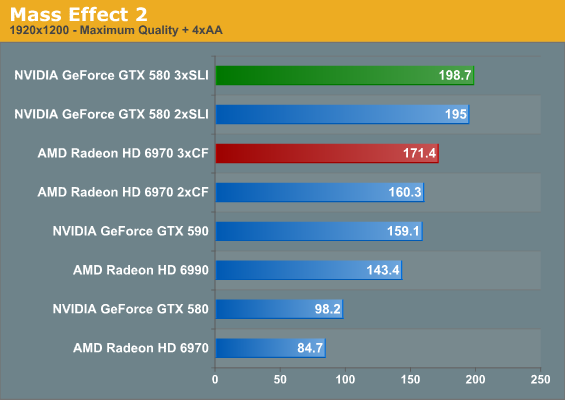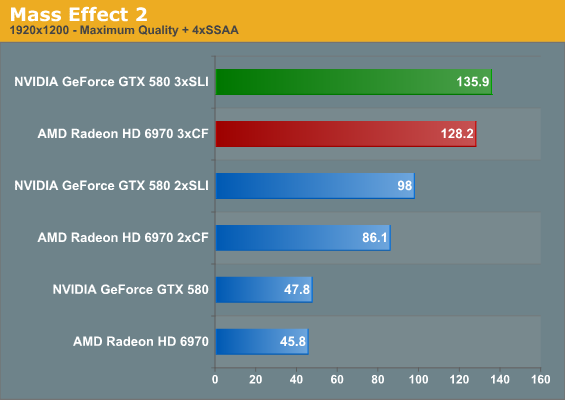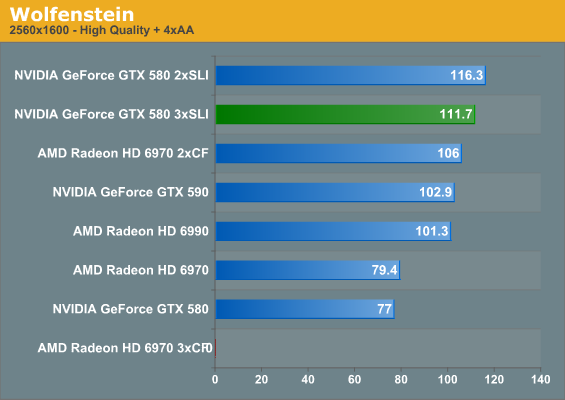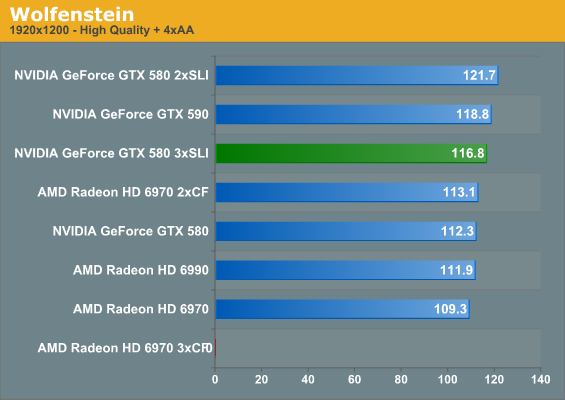A Look At Triple-GPU Performance And Multi-GPU Scaling, Part 1
by Ryan Smith on April 3, 2011 7:00 AM ESTMass Effect 2, Wolfenstein, and Civ V Compute


Mass Effect 2 is a game we figured would be GPU limited by three GPUs, so it’s quite surprising that it’s not. It does look like there’s a limit at around 200fps, but we can’t hit that at 2560 even with three GPUs. You can be quite confident with two or more GPUs however that your framerates will be nothing short of amazing.

For that reason, and because ME2 is a DX9-only game, we also gave it a shot with SSAA on both the AMD and NVIDIA setups at 1920. Surprisingly it’s almost fluid in this test even with one GPU. Move to two GPUs and we’re looking at 86fps – again this is with 4x super sampling going on. I don’t think we’re too far off from being able to super sample a number of games (at least the console ports) with this kind of performance.


Wolfenstein is quite CPU limited even with two GPUs, so we didn’t expect much with three GPUs. In fact the surprising bit wasn’t the performance, it was the fact that AMD’s drivers completely blew a gasket with this game. It runs fine with two GPUs, but with three GPUs it will crash almost immediately after launching it. Short of a BSOD, this is the worst possible failure mode for an AMD setup, as AMD does not provide individual game settings for CF, unlike NVIDIA who allows for the enabling/disabling of SLI on a game-specific basis. As a result the only way to play Wolfenstein if you had a triple-GPU setup is to change CrossFire modes globally, which requires a hardware reconfiguration that takes several seconds and a couple of blank screens.
We only have one OpenGL game in our suite so we can’t isolate this as an AMD OpenGL issue or solely an issue with Wolfenstein. It’s disappointing to see AMD have this problem though.

We don’t normally look at multi-GPU numbers with our Civilization V compute test, but in this case we had the data so we wanted to throw it out there as an example of where SLI/CF and the concept of alternate frame rendering just doesn’t contribute much to a game. Texture decompression needs to happen on each card, so it can’t be divided up as rendering can. As a result additional GPUs reduce NVIDIA’s score, while two GPUs does end up helping AMD some only for a 3rd GPU to bring scores crashing down. None of this scores are worth worrying about – it’s still more than fast enough for the leader scenes the textures are for, but it’s a nice theoretical example.
| Radeon HD 6970 | GeForce GTX 580 | |||||
| GPUs | 1->2 | 2->3 | 1->3 | 1->2 | 2->3 | 1->3 |
| Mass Effect 2 | 180% | 142% | 158% | 195% | 139% | 272% |
| Mass Effect 2 SSAA | 187% | 148% | 280% | 198% | 138% | 284% |
| Wolfenstein | 133% | 0% | 0% | 151% | 96% | 145% |
Since Wolfenstein is so CPU limited, the scaling story out of these games is really about Mass Effect 2. Again dual-GPU scaling is really good, both with MSAA and SSAA; NVIDIA in particular achieves almost perfect scaling. What makes this all the more interesting is that with three GPUs the roles are reversed, scaling is still strong but now it’s AMD achieving almost perfect scaling on Mass Effect 2 with SSAA, which is quite a feat given the uneven scaling of triple-GPU configurations overall. It’s just a shame that AMD doesn’t have a SSAA mode for DX10/DX11 games; if it was anything like their DX9 SSAA mode, it could certainly sell the idea of a triple GPU setup to users looking to completely eliminate all forms of aliasing at any price.
As for Wolfenstein, with two GPUs NVIDIA has the edge, but they also had the lower framerate in the first place. Undoubtedly being CPU limited even with two GPUs, there’s not much to draw from here.










97 Comments
View All Comments
marc1000 - Monday, April 4, 2011 - link
Ryan, if at all possible, please include a reference card for the "low-point" of performance. We rarely see good tests with mainstream cards, only the top tier ones.So if you can, please include a radeon-5770 or GTX460 - 2 of these cards should have the same performance as one of the big ones, so it would be nice to see how well they work by now.
Ryan Smith - Wednesday, April 6, 2011 - link
These charts were specifically cut short as the focus was on multi-GPU configurations, and so that I could fit more charts on a page. The tests are the same tests we always run, so Bench or a recent article ( http://www.anandtech.com/show/4260/amds-radeon-hd-... ) is always your best buddy.Arbie - Monday, April 4, 2011 - link
Looking at your results, it seems that at least 99.9% of gaming enthusiasts would need nothing more than a single HD 6970. Never mind the wider population of PC-centric folk who read Anandtech.More importantly, this isn't going to change for several years. PC game graphics are now bounded by console capabilities, and those advance only glacially. In general, gamers with an HD 6850 (not a typo) or better will have no compelling reason to upgrade until around 2014! I'm very sad to say that, but think it's true.
Of course there is some technical interest in how many more FPS this or that competing architecture can manage, but most of that is a holdover from previous years when these things actually mattered on your desktop. I'm not going to spend $900 to pack two giant cooling and noise problems into my PC for no perceptible benefit. Nor will anyone else, statistically speaking.
The harm in producing such reports is that it spreads the idea that these multi-board configurations still matter. So every high-end motherboard that I consider for my next build packs in slots for two or even three graphics boards, and an NF-200 chip to make sure that third card (!) gets enough bandwidth. The mobos are bigger, hotter, and more expensive than they need to be, and often leave out stuff I would much rather have. Look at the Gigabyte P67A-UD7, for example. Full accommodation for pointless graphics overkill (praised in reviews), but *no* chassis fan controls (too mundane for reviewers to mention).
I'd rather see Anandtech spend time on detailed high-end motherboard comparisons (eg. Asus Maximus IV vs. others) and components that can actually improve my enthusiast PC experience. Sadly, right now that seems to be limited to SSDs and you already try hard on those. Are we reduced to... fan controllers?
Thanks,
Arbie
erple2 - Tuesday, April 5, 2011 - link
There are still several games that are not Console Ports (or destined to be ported to a console) that are still interesting to read about and subsequently benchmark. People will continue to complain that PC Gaming has been a steady stream of Console Ports, just like they have been since the PSX came out in late '95. The reality is that PC Gaming isn't dead, and probably won't die for a long while. While it may be true that EA and company generate most of their revenue from lame console rehash after lame console rehash, and therefore focus almost single-mindedly on that endeavor, there are plenty of other game publishers that aren't following that trend, thereby continuing to make PC Gaming relevant.The last several tests I've seen of Motherboard reviews has more or less convinced me that they just don't matter at all any more. Most (if not all) motherboards of a given chipset don't offer anything performance wise over other competing motherboards.
There are nice features here and there (Additional Fan Headers, more USB ports, more SATA Ports), but on the whole, there's nothing significant to differentiate one Motherboard from another, at least from a performance perspective.
789427 - Monday, April 4, 2011 - link
I would have thought that someone would pay attention to if throttling was occurring on any of the cards due to thermal overload.The reason is that due to differences in ventilation in the case, layout and physical card package, you'll have throttling at different times.
e.g. if the room was at a stinking hot 50C, the more aggressive the throttling,the greater the disadvantage to the card.
Conversely, operating the cards at -5C would provide a huge advantage to the card with the worst heat/fan efficiency ratio.
cb
TareX - Monday, April 4, 2011 - link
I'm starting to think it's really getting less and less compelling to be a PC gamer, with all the good games coming out for consoles exclusively.Thank goodness for Arkham Asylum.
Golgatha - Monday, April 4, 2011 - link
I'd like to see some power, heat, and PPD numbers for running Folding@Home on all these GPUs.Ryan Smith - Monday, April 4, 2011 - link
The last time I checked, F@H did not having a modern Radeon client. If they did we'd be using it much more frequently.karndog - Monday, April 4, 2011 - link
Cmon man, you have an enthusiast rig with $1000 worth of video cards yet you use a stock i7 at 3.3ghz??"As we normally turn to Crysis as our first benchmark it ends up being quite amusing when we have a rather exact tie on our hands."
Ummm probably because your CPU limited! Update to even a 2500k at 4.5ghz and i bet you'll see the Crossfire setup pull away from the SLI.
karndog - Monday, April 4, 2011 - link
Not trying to make fun of your test rig, if that's all you have access too. Im just saying that people who are thinking about buying the Tri SLI / Xfire video card setups reviewed here arent running their CPU at stock clock speeds, especially such low ones, which skew the results shown here.